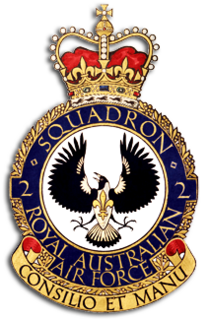
No. 2 Squadron is a Royal Australian Air Force (RAAF) squadron that operates from RAAF Base Williamtown, near Newcastle, New South Wales. From its formation in 1916 as part of the Australian Flying Corps, it has flown a variety of aircraft types including fighters, bombers, and Airborne Early Warning & Control (AEW&C). During World War I, the squadron operated on the Western Front conducting fighter sweeps and ground-attack missions. It was disbanded in mid-1919, following the end of hostilities. The squadron was briefly re-raised in 1922 as part of the newly independent RAAF, but was disbanded after only a couple of months and not reformed until 1937. It saw action as a bomber unit in the South West Pacific theatre of World War II and, equipped with English Electric Canberra jets, in the Malayan Emergency and the Vietnam War. The squadron was again disbanded in 1982, following the retirement of the Canberra. It was re-formed in 2000 to operate the Boeing 737 AEW&C "Wedgetail". One of the six Boeing 737s was deployed to the Middle East in September 2014, as part of Australia's contribution to the military coalition against ISIS.
The Royal Australian Air Force (RAAF) traces its history back to the Imperial Conference held in London in 1911, where it was decided aviation should be developed within the Armed Forces of the British Empire. Australia implemented this decision, the only country to do so, by approving the establishment of the Central Flying School (CFS) in 1912. The location for the proposed school was initially to be at Duntroon, Australian Capital Territory, but in July 1913 Point Cook, Victoria, was announced as the preferred location. The first flights by CFS aircraft took place there in March 1914.

No. 43 Squadron was a Royal Australian Air Force (RAAF) maritime patrol and mine-laying squadron that operated during World War II. Raised in early 1943, the squadron flew Catalina aircraft from bases in Queensland and the Northern Territory, flying mine-laying, convoy-protection and bombing sorties against Japanese targets in the Pacific theatre. These operations saw it operate as far north as the Chinese coast. After the conclusion of hostilities, the squadron was disbanded in mid-1946.
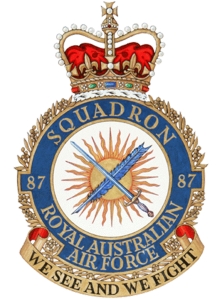
No. 87 Squadron is a Royal Australian Air Force (RAAF) air intelligence squadron. It saw action during World War II as a photo reconnaissance squadron, being raised in September 1944 through the re-designation of No. 1 Photo Reconnaissance Unit, which had been formed in June 1942. Throughout the war, No. 87 Squadron flew a variety of aircraft from bases in Australia, gathering photographic intelligence on Japanese forces and installations throughout the Pacific. At the conclusion of hostilities, the squadron was disbanded but was later re-formed in 1948, carrying out aerial survey operations in Australia until 1953. In 2006, it was re-raised again as a non-flying squadron tasked with air intelligence analysis as part of the Information Warfare Directorate within the RAAF's Air Warfare Centre.

No. 13 Squadron is a Royal Australian Air Force (RAAF) squadron. The unit saw combat during World War II as a bomber and maritime patrol squadron and is currently active as a mixed regular and reserve RAAF unit located in Darwin, fulfilling both operational support and training duties.

No. 12 Squadron was a Royal Australian Air Force (RAAF) general purpose, bomber and transport squadron. The squadron was formed in 1939 and saw combat in the South West Pacific theatre of World War II. From 1941 to 1943, it mainly conducted maritime patrols off northern Australia. The squadron was based at Merauke in western New Guinea from November 1943 to July 1944, when it was withdrawn from operations. After being re-equipped, it operated as a heavy bomber unit from February 1945 until the end of the war. The squadron continued in this role until it was redesignated No. 1 Squadron RAAF in February 1948. The squadron was reformed in 1973 to operate transport helicopters but was again disbanded in 1989.
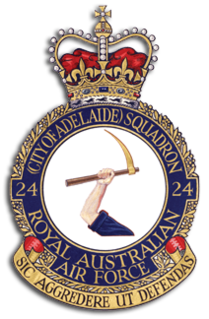
No. 24 Squadron is a Royal Australian Air Force squadron. The squadron was formed in 1940 and saw action as a bomber squadron during World War II serving in the Pacific theatre against the Japanese, and undertaking operations during the Battle of Rabaul, and the New Guinea, New Britain and Borneo campaigns. The squadron was disbanded in 1946 following the conclusion of hostilities, but was re-formed in 1951. From then until 2010 the squadron was an RAAF Reserve squadron located near Adelaide, South Australia; for part of this time, until 1960, the squadron continued to perform flying duties, before converting to a ground support role. In 2010, the squadron combined with Combat Support Unit Edinburgh to become a Permanent Air Force unit and it currently forms part of No. 96 Wing, Combat Support Group.

No. 102 Squadron was a Royal Australian Air Force (RAAF) heavy bomber squadron of World War II. The squadron was only active for less than nine months before being disbanded. No. 102 Squadron was formed at Cecil Plains, Queensland on 31 May 1945. The Squadron's B-24 Liberator bombers arrived in July. While the Squadron began training on these aircraft, the war ended before it reached operational status. Following the end of the war the squadron operated in the transport role until December 1945. No. 102 Squadron was disbanded on 19 March 1946.

No. 100 Squadron was a Royal Australian Air Force (RAAF) bomber and maritime patrol squadron that operated during World War II. Raised in early 1942 from the remnants of a British unit that had been destroyed in Malaya, the squadron flew Bristol Beauforts from bases in Queensland and New Guinea, undertaking torpedo- and level-bombing sorties against Japanese targets in the Pacific theatre. Following the conclusion of hostilities, the squadron was disbanded in August 1946.
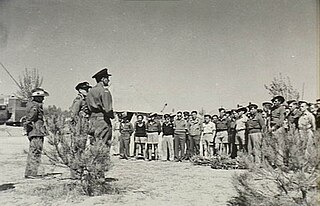
No. 454 Squadron was a unit of the Royal Australian Air Force (RAAF) that served during World War II. The squadron was raised in Australia under the Empire Air Training Scheme in mid-1941, but was disbanded shortly afterwards. It was re-formed later in 1941 from mainly British personnel and subsequently took part in the fighting in the Mediterranean and Middle East theatre before being disbanded in August 1945.

No. 21 Squadron is a Royal Australian Air Force (RAAF) general reserve squadron. Formed in the mid-1930s as a unit of the part-time Citizen Air Force (CAF), it was mobilised for service during World War II, when it saw action against the Japanese as a fighter unit in the Malayan campaign, a dive bomber unit in the New Guinea campaign, and a heavy bomber unit in the Borneo campaign. After the war, the squadron continued to fly until 1960, when the CAF ceased flying operations. At that time, No. 21 Squadron converted to a non-flying support role, which it currently fulfils at RAAF Williams.
No. 23 Squadron of the Royal Australian Air Force (RAAF) is a non-flying base operations and training squadron headquartered at RAAF Base Amberley near Brisbane, Queensland. The squadron was formed in 1937 and saw action against the Japanese during World War II as a bomber squadron. Operating from Archerfield during the early stages of the war, the squadron undertook maritime patrols off Australia's east coast before converting to a dive-bomber role and taking part in the New Guinea campaign. Later in the war, the squadron converted to Liberator heavy bombers and flew missions against Japanese targets in the Netherlands East Indies. After the war, No. 23 Squadron was used to reform No. 6 Squadron and was then re-raised as a Citizens Air Force unit based in Brisbane. Until 1960, the squadron flew jet fighter aircraft before converting to a ground support role and now forms part of the RAAF's Combat Support Group.

No. 25 Squadron is a general reserve squadron of the Royal Australian Air Force (RAAF). It is based at RAAF Base Pearce in Perth, Western Australia, and forms part of the Combat Reserve Wing. The squadron was formed in early 1937 and until early 1939 was designated as "No. 23 Squadron". During World War II, it provided local air defence for the Perth region, before undertaking Army co-operation duties in 1943–1944 and then converting to the heavy bomber role in 1945. In the heavy bomber role, the squadron took part in operations against Japanese targets in the Netherlands East Indies and supported Allied ground operations during the Borneo Campaign.
No. 462 Squadron is a Royal Australian Air Force (RAAF) squadron which forms part of the Information Warfare Directorate in the RAAF's Air Warfare Centre. The squadron was first formed in 1942 as a heavy bomber unit and saw combat in this role in the Mediterranean area until it was disbanded in March 1944. It was reformed in the United Kingdom in August 1944 to participate in the bombing campaign against Germany, and in December that year converted to a specialist electronic warfare unit. No. 462 Squadron continued in this role until the end of the European war in May 1945 and was disbanded in September that year. The squadron was reformed in its current role during April 2005.

No. 8 Squadron was an Australian flying training squadron of World War I and medium bomber squadron of World War II. The squadron was formed in England in October 1917 as part of the Australian Flying Corps, and disbanded in April 1919. It was re-formed by the Royal Australian Air Force in September 1939. After seeing action during the Pacific War flying Lockheed Hudson and, later, DAF Beaufort bombers, the squadron was disbanded a second time in January 1946.

No. 82 Squadron RAAF was a Royal Australian Air Force fighter squadron that operated during World War II and its immediate aftermath. It was formed in June 1943, flying Curtiss P-40 Kittyhawks and, initially, Bell P-39 Airacobras from bases in Queensland and New Guinea. The squadron became operational in September 1944, and undertook ground attack missions against Japanese targets in the Pacific theatre. Following the end of hostilities, No. 82 Squadron was re-equipped with North American P-51 Mustangs and deployed to Japan, where it formed part of the British Commonwealth Occupation Force. It remained there until October 1948, when it was disbanded.

No. 79 Wing was a Royal Australian Air Force (RAAF) wing of World War II. It was formed in December 1943 at Batchelor, Northern Territory, as part of North-Western Area Command. Led by Group Captain Charles Eaton, the wing comprised four squadrons on its establishment, flying Beaufort and B-25 Mitchell bombers and Beaufighter heavy fighters. No. 79 Wing took part in the New Guinea and North-Western Area Campaigns during 1944–45, eventually transferring to Balikpapan in the Dutch East Indies as the Allies advanced northward. By the end of the Pacific War, the wing was attached to the Australian First Tactical Air Force and was made up of Nos. 2 and 18 Squadrons, both flying Mitchells. The latter transferred to the Netherlands Air Force in late 1945, while the former returned to Australia where it disbanded the following year. No. 79 Headquarters itself disbanded in October 1945, soon after the end of hostilities.
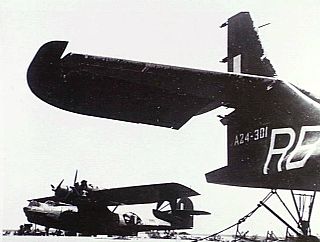
No. 76 Wing was a Royal Australian Air Force (RAAF) wing that operated during World War II. Initially based in Far North Queensland, its headquarters transferred to Darwin, Northern Territory, in September 1944 to take control of three PBY Catalina units: Nos. 20, 42, and 43 Squadrons. The prime task of these squadrons was minelaying in the South West Pacific theatre, and they conducted these operations as far afield as Java, Borneo, the Philippines, and China. As well as minelaying, No. 76 Wing's Catalinas flew bombing, patrol, and transport missions, and dropped millions of propaganda leaflets in the closing months of the war. The wing headquarters disbanded in November 1945.
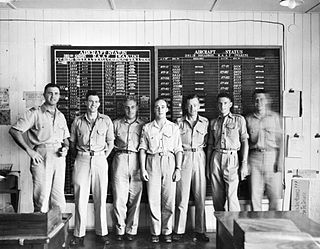
No. 391 (Base) Squadron was a Royal Australian Air Force (RAAF) squadron that operated during the Korean War and its immediate aftermath. It was established in October 1950 as part of No. 91 (Composite) Wing, which administered RAAF units deployed in the conflict. Apart from No. 391 Squadron, these included No. 77 (Fighter) Squadron, No. 30 Communications Unit, and No. 491 (Maintenance) Squadron. No. 391 Squadron was headquartered at Iwakuni, Japan, as were No. 91 Wing's other components with the exception of No. 77 Squadron, which was located on the Korean peninsula. The base squadron was responsible for administrative, logistical, medical, communications and security functions at Iwakuni, and also maintained detachments in South Korea. It included a marine section for harbour patrols and search-and-rescue in the waters off southern Japan. No. 391 Squadron was disbanded at the same time as No. 91 Wing headquarters, in April 1955.
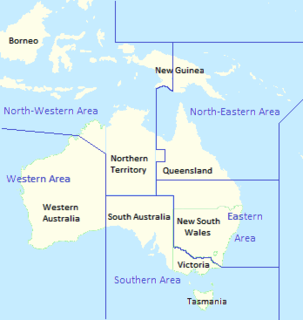
North-Western Area Command was one of several geographically based commands raised by the Royal Australian Air Force (RAAF) during World War II. Its wartime sphere of operations included the Northern Territory, adjacent portions of Queensland and Western Australia, and the Dutch East Indies. The command was formed in January 1942, following the outbreak of the Pacific War, from the western part of Northern Area Command, which had covered all of northern Australia and Papua. Headquartered at Darwin, North-Western Area Command was initially responsible for air defence, aerial reconnaissance and protection of the sea lanes within its boundaries.

















